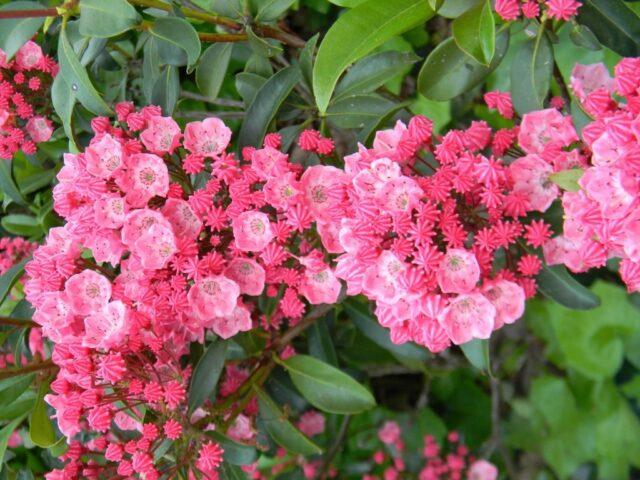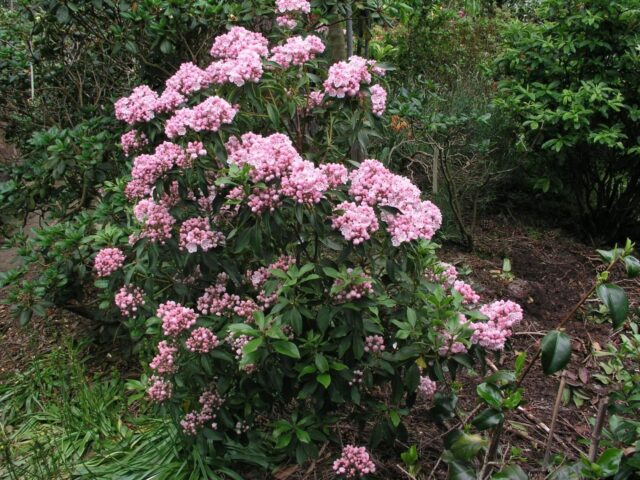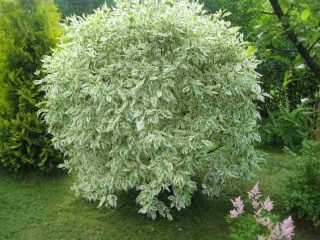Content
Kalmia (lat. Kalmia) is a genus of evergreen shrubs belonging to the Heather family. It has about ten species. North America is considered the birthplace of the culture. The shrub is valued for the bright color of its flowers, which look impressive in combination with the foliage. Recently, it has attracted the attention of landscape designers, which has contributed to the growth of its popularity. However, not all types of perennials are suitable for growing in the Moscow region. Therefore, you need to study in advance the photo and description of kalmia, varieties of which will be able to winter in the middle zone and delight with lush flowering.

The beauty of Kalmia is not much inferior to that of rhododendron.
Description of Kalmia
This woody plant remains decorative all year round. Its height varies from 30 cm to 2.5 m. The shoots are erect, branched.Initially they have a greenish color with a reddish tint, but when ripe they become brown.
The leaves resemble laurel blades in appearance. They have an elongated oval shape with a pointed end. Kalmia's plates are 3-15 cm long and 2 to 4 cm wide. Their surface is bright green, smooth, and the reverse side is light gray, rough. The leaves are located on the shoots oppositely or in a spiral. The perennial has a shallow root system. It consists of many thin processes.
The flowering period occurs in late May, early June or mid-summer, depending on the species. The buds reach 1-3 cm in diameter. Kalmia flowers, as can be seen in the photo, are collected in lateral umbrella inflorescences, of which several are formed on one shoot. This ensures lush flowering of the perennial for 3-4 weeks.
A special feature of Kalmia is the unusual cross-pollination of its flowers. When closed, the stamens of the plant rest against the recesses on the petals, and when the buds open, they deviate to the sides. But as soon as the insect enters the bud, a springy mechanism is triggered and the stamen is released, generously showering it with pollen.
The shrub has capsule fruits that appear on the plant at the end of summer. They contain many small seeds. The fruits ripen in September-October, depending on the type. At the same time, the doors open and the seeds spill out onto the soil. Therefore, every year the Kalmia thickets become denser if self-seeding is not controlled.
Types and varieties of Kalmia
Kalmia has been cultivated since the 18th century.In gardening, only certain types of crops are used, which are highly decorative and unpretentious. It was they who became the basis for the development of new varieties.
Kalmia multifolia
In nature, the plant reaches a height of 80-180 cm, and in a personal plot it is 60 cm and the same diameter of growth of the bush. Kalmia polifolia is characterized by a slow rate of development. The annual growth of the shrub is only a few centimeters. The color of the flowers of this type of crop is pink.

Kalmia multifolia is also called marsh laurel.
Kalmia angustifolia
This species can only be found in the wild. And only decorative varieties obtained on its basis are popular among gardeners. The stems of Kalmia angustifolia are no more than 6 cm long and about 2.5 cm wide. The wild-growing form is characterized by a pink tint of the buds. This species blooms in June and continues throughout the month.

Varietal forms of Kalmia angustifolia are mainly two-colored
Kalmia recumbent
This is a miniature creeping plant. The leaves of Kalmia procumbens are leathery, dense, about 1 cm long, with a short petiole. The flowering period for this type of crop begins in July-August, and within a month fruits appear on the bush. The flowers are five-dimensional, with curved, pointed petals. They are collected in apical umbrella inflorescences of 2-5 pieces.

Kalmia recumbent is an evergreen ground cover.
Kalmia latifolia
A tall type of crop, which in its natural habitat reaches a height of 1.5-3 m, and in some cases even 9 m. Broad-leaved Kalmia (Kalmia latifolia) is characterized by slow development; every year the shrub adds no more than 2 cm.Compared to the narrow-leaved species, this plant is less frost-resistant, but its buds are much larger.
Initially, the flowers are cup-shaped, but when fully bloomed they become saucer-shaped. They mostly have a pink tint of varying intensities. The species blooms in May-June on last year's shoots.

Kalmia latifolia is the state symbol of Connecticut.
Kalmia parvifolia
This species is in many ways similar in flowers to multileaf. But unlike the latter, its buds are collected in racemose rather than corymbose inflorescences. The plant is a compact shrub, the height of which reaches 50-80 cm, but sometimes even 2 m. Small-leaved Kalmia (Kalmia microphylla) actively develops in spring and in the first half of summer. The branches of the shrub are initially pubescent green, but as they mature they become red-brown or gray.

Kalmia smallifolia has pink or purple flowers.
Kalmia boxifolia
The height of this species varies from 10 to 100 cm. The stems of the shrub are elastic, densely leafy and highly branched, so the crown is lush and spreading. The leaves are small, 2 cm long, with tips curved down. The color of the flowers is white or light pink. Boxleaf Kalmia (Kalmia buxifolia) is characterized by abundant flowering; when the buds open, the leaves are practically invisible.

Inflorescences of Kalmia boxifolia include 18 buds
Frost-resistant varieties
Kalmiya belongs to the category of heat-loving crops. And only the narrow-leaved species is characterized by increased winter hardiness. It can withstand frosts down to -34 °C. Also, thanks to selection, it was possible to increase the resistance of broadleaf Kalmia to low temperatures. This made it possible to grow this perennial shrub in the middle zone and Moscow region.
Modern frost-resistant varieties of Kalmia:
- Bandeau. A profusely flowering shrub, up to 1.3 m high. The plant has dark green ellipsoid leaves and large pale pink flowers with dark burgundy contrasting dots. The variety blooms at the end of May, at the beginning of June.
Bando has a slow growth rate
- Beacon. A German variety of Kalmia, which was registered in 2008. Shoots with a reddish tint. The leaves are dark green, up to 10 cm long. The buds are intense pink in color, up to 70 pieces in an inflorescence. There are dark red spots in the recesses under the anthers, and there is a clear red rim above the ovary.
Biacon has increased resistance to adverse external factors
- Elf. Miniature variety, bred in 1982. The height of the bush reaches 80 cm and the width is 70 cm. The leaves are small, dark green, leathery. The flowers are snow-white, but there is a scarlet “star” on the cups.
Elf is resistant to leaf spot
- Black Label. German variety of Kalmia. At the age of ten, the height of the bush, as well as the width, is 2.6 m. The leaves are small, dark green, leathery with a glossy surface. The main shade of the flowers is white, but inside there is a dark brown wide ring.
Black Label has up to 70 buds per inflorescence
- Ewa. German winter-hardy variety obtained by crossing the Nancy and Harmony species. Registered in 2009. The shrub is spreading, with a moderate growth rate. At the age of ten, the height of the plant reaches 130 cm.The flowers are light pink in color with dark chestnut streaks where the stamens touch the petals. The diameter of the buds when opened reaches 3 cm.
Eve is distinguished by abundant flowering
Planting Kalmia
For successful development and rapid adaptation of the seedling, it is necessary to plant it taking into account the requirements of the crop. But when working, you need to take into account that kalmia is a poisonous plant, so it is recommended to take precautions.
For this heather crop, a place under the canopy of trees that forms openwork partial shade is suitable. After all, under direct sunlight, burns appear on the leaves of the plant. The area for kalmiya should be protected from cold gusts of wind.
When choosing a place for planting, you also need to take into account that the crop prefers acidic soil in the range of 4.5-5.5 pH. It is recommended to move Kalmia seedlings to a permanent place in the spring, when the soil has warmed up well and the threat of return frosts has passed. It is best to purchase plants with a closed root system, since the crop reacts sharply to its drying out.
Two weeks before planting, it is necessary to prepare a hole measuring 50 by 50 cm. A layer of sand 5-7 cm thick should be poured onto the bottom of it to prevent moisture stagnation, and the rest of the volume should be filled with a nutrient mixture consisting of high-moor peat, leaf soil and pine litter in proportions 2:3:1.
Planting of this shrub is carried out according to the standard scheme. Upon completion, the root collar of the plant should be located at soil level. After this, water the bush generously, and the next day mulch the soil at its base with humus.When planting several seedlings at the same time, the distance between them should be 80-120 cm, depending on the diameter of the growth of the bushes.

Kalmiya does not grow on clay and sandy soils
Kalmia care
For the full development of narrow-leaved and broad-leaved Kalmiya, it is necessary not only to plant correctly, but also to provide adequate care for the perennial. It involves the implementation of several basic activities, the features of which need to be familiarized in advance.
Watering and fertilizing
In the Moscow region, it is necessary to water Kalmia regularly in the absence of seasonal rains. Humidification is best done in the evening, using settled water. During particularly hot periods, foliar sprinkling is also recommended. Periodically, water for watering Kalmiya must be acidified at the rate of 1 tsp. citric acid per 10 liters of water. This will improve the development of the bush and the absorption of nutrients by the plant. It is recommended to water Kalmiya 1-2 times a week, depending on the air temperature.
You need to feed the perennial 1-2 times per season. In this case, you can use special mineral fertilizers for rhododendrons, taking into account their stage of development. You need to start fertilizing from the third year after planting the seedling, since before that the plant will use the nutritional components added to the hole.
Trimming
Due to the slow growth rate of the shrub, it is necessary to prune Kalmiya moderately, only to maintain its decorative effect. It is recommended to remove faded inflorescences, as well as broken and damaged shoots. Kalmia does not need more drastic pruning.
Wintering
For the first 3-4 years after planting, seedlings of this perennial must be insulated for the winter in the conditions of the Moscow region.Preparations should begin at the end of September. During this period, it is recommended to water the bush and then lay peat mulch at its base 10 cm thick.
After the onset of stable frosts around the bush, it is necessary to install a wooden frame at the height of its growth, wrap it several times with agrofibre, and then cover it with spruce branches on top.
Reproduction methods
To obtain new seedlings of this ornamental shrub, you can use seeds and cuttings. But the first option can only be used for propagating species of Kalmia, since the grown plants do not retain varietal qualities.
Seeds
Perennial seeds must be collected in the fall. The inflorescences must be cut in advance and placed on the windowsill until the fruits are fully ripened. It is recommended to mix the collected seeds with wet peat, pour the mixture into a plastic bag and place it in the refrigerator for eight weeks. During this time, the material should not dry out.

Kalmiya grown from seeds blooms in 6-7 years
After stratification is completed, you need to sow the seeds in wide containers filled with peat and sand in a 2:1 ratio. And on top they need to be covered with a layer of sphagnum moss, as well as film or glass, which will maintain an optimal level of humidity. After this, it is recommended to move the container to a bright windowsill and ensure that it is kept within +21-22 °C. It is recommended to ventilate the plantings daily for 5-10 minutes.
If all conditions are met, friendly shoots appear after 30 days. Kalmia seedlings need to be watered moderately and regularly. But at the same time, drying out or stagnation of moisture in the soil should not be allowed.When the seedlings become stronger, they need to be adapted to new conditions and the cover must be completely removed. At the stage of 2-3 true leaves, seedlings must be planted in separate containers. You can transfer them to open ground when they are strong enough.
Cuttings
The perennial can also be propagated vegetatively. For this purpose, apical cuttings cut from annual shoots are suitable. They should be 5-7 cm long. Remove the leaves from the cuttings at the bottom and place them in a root former solution.
It is recommended to plant them in a soil mixture of peat, sand and perlite in a ratio of 2:2:1. Recommended maintenance temperature +22+24 °C. For successful rooting of cuttings, it is necessary to constantly keep the substrate slightly moist. Therefore, you need to make a small greenhouse and ventilate it regularly.
Diseases and pests of Kalmia
This perennial has high natural immunity. But failure to follow the rules of care leads to a decrease in its stability.
Possible problems:
- Chlorosis. The disease can be recognized by the light shade of the plates, but the veins remain green. The reason is alkalization of the soil. In this case, the bush needs to be watered with acidified water and then fed.
- Whitefly. If they touch the bush, a swarm of white flies flies up. To fight, you need to simultaneously water the bush with Aktara and spray it with Actellik. Repeat the procedure three times every week.
- Leaf spotting. The disease develops during prolonged rainy weather. Dark spots form on the leaves, the size of which increases. This leads to a decrease in decorativeness.For treatment, it is necessary to spray the plant with Bordeaux mixture or copper sulfate.
Photo of Kalmia in landscape design
The Kalmiya bush, as can be seen in the photo, has found wide application in landscape design. It can act as a tapeworm and also look impressive in group plantings. But, taking into account the requirements of the culture, only plants that prefer acidic soil and diffused light are suitable as neighbors for this perennial.

Kalmia can successfully disguise unsightly places in the garden

Perennial can decorate the root zone of tall crops

Shrub plantings also look impressive against the backdrop of rocky boulders.
Conclusion
Having studied the photo and description of kalmia, we can say that this perennial can become a real decoration of the garden and any personal plot. In order for the plant to fully develop in the Moscow region, it is necessary to take a responsible approach to the selection of frost-resistant varieties. It is also recommended to take into account the basic preferences of the shrub, since it, like rhododendron, is picky about the composition of the soil.
Reviews about growing Kalmia in the Moscow region













